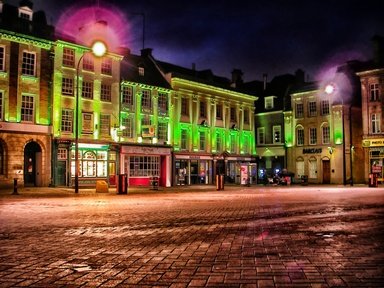Quiz Answer Key and Fun Facts
1. Let's start with a triangular square. This shape is rather popular in Flanders and the Netherlands. One example is a square in Antwerp, where we can find the main entrance to the Cathedral of Our Lady. There is also a well, decorated in wrought iron, ascribed to the Antwerp painter Quentin Matsys. What is the name of this square, which I'd dare to translate as "Glove Square"?
2. Many squares throughout the world are rectangular in shape, not square. Let's visit Beijing for an example: the Tienanmen Square is a large rectangle. What is the common translation into English of the words Tien An Men?
3. We move on to an odd-shaped square with as principal attraction a large Egyptian obelisk. On which Parisian square do we find one end of the Champs Elysées, whilst the other end is at the Place Charles de Gaulle?
4. Circular squares are quite rare. Cairo presents a circular square, where demonstrators pro and contra President Mubarak clashed in 2011, and demonstrators pro President Morsi violently opposed the army after they deposed Morsi in 2013. What is the name of this Square?
5. Trapezoid squares are less common than rectangular ones. Stockholm's main square is roughly a trapezium, if we take it as a whole (the pedestrian area is a triangle). What is the name of this square?
6. Auckland, New Zealand, has a square with a very distinct ground plan, namely in the shape of one half of a human heart. Named after a mythical canoe, what is the name of this square?
7. Another square with a quite original ground plan is the Syntagma Square (Constitution Square), in the original language Plateia Syntagmatos. It is shaped as a Gothic arched window: a rectangle crowned with a semi-circle. In which city do we find the Syntagma Square?
8. Buenos Aires holds a square with a ground plan that resembles a mushroom: a rectangle ending in an ellipse. Which protest movement (that marched from 1977 until 2006 each week) was named after the Square?
9. Right before the entrance of the principal Catholic church, St. Peter's Basilica in Vatican City, is St. Peter's Square. The ground plan of this square resembles a shell. Who was the principal architect of this Square, who worked on it between 1656 and 1667?
10. Wellington, New Zealand, has a square designed in the shape of a glass shard. Around this square we find the town hall, the City Gallery and the Wellington central Library. What is the name of this square?
Source: Author
JanIQ
This quiz was reviewed by FunTrivia editor
stedman before going online.
Any errors found in FunTrivia content are routinely corrected through our feedback system.


